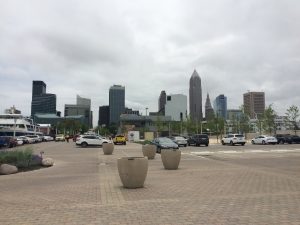 I was recently in Akron presenting a forthcoming paper of mine. One of the interesting things about the Northeast Ohio constellation of cities is that there’s a very weak sense of regional identity. In almost any other context, Cleveland and Akron would be considered some type of twin city ecosystem.
I was recently in Akron presenting a forthcoming paper of mine. One of the interesting things about the Northeast Ohio constellation of cities is that there’s a very weak sense of regional identity. In almost any other context, Cleveland and Akron would be considered some type of twin city ecosystem.
Consider:
- Dallas and Ft. Worth are 32 miles apart.
- Seattle and Tacoma are 34 miles about.
- Cleveland and Akron are 39 miles apart.
Cleveland’s Cuyahoga County and Akron’s Summit County are also physically contiguous. Yet, Cleveland and Akron do not seem to share a strong sense of regional identity, but rather view themselves as independent cities and regions. The same would also be true with Akron and its smaller neighbor Canton. Youngstown is also similar, though less proximate than those other cities.
All of these cities have their own officially designated metropolitan areas. This makes Northeast Ohio regions seem underpowered vs. the rest of the state. Columbus will tell you they are the biggest city (municipality) in the state. Cincinnatians will say they are the largest metro area. But clearly Northeast Ohio is the largest urban region Ohio. If we use the largest measure of an urban trading area, the BEA Economic Area, Northeast Ohio is 4.5 million people. Columbus is at 2.8 million, and Cincinnati barely larger than its MSA population at only 2.4 million.
Still, it’s fair to say that the region hasn’t figured out how to work together. In that sense, the division into separate urban identities and MSAs reflects an underlying reality.
Regionalism is a sort of conventional wisdom best practice. So almost everyone at least gives it lip service. But what does regionalism look like in a region where cities don’t think of themselves as being part of a functional region? Previous attempts to market the area as Cleveland+ apparently didn’t go over well in other cities, though the label still seems to have some currency. You can view the web site here. The economic development marketing group calls themselves TeamNEO, which I suspect is better digested.
I have always advocated that a greater sense of a shared identity and destiny is important for regions and states. However, this also has to take account of reality. These cities think of themselves as distinct places. There’s nothing wrong with that. So the challenge is to develop a regionalism concept that works with instead of against this grain. Historically there doesn’t appear to have been much of anything related to this in Northeast Ohio, so the communities there are having to figure it out today. So it’s to be expected that they will need to evolve and iterate on it vs. other places with more historic regional form.
The important point is that the cultural givens of a particular place or region need to be understood and used as inputs into policy. This applies to all regions, which each have their own unique quirks. This is part of what gives them their unique charm. There can be cases where regional cultural traits need to be changed, but if you’re swimming against the tide on that you need to understand how difficult this undertaking will be.
from Aaron M. Renn
http://www.urbanophile.com/2018/02/06/the-strange-case-of-civic-identity-in-northeast-ohio/
No comments:
Post a Comment